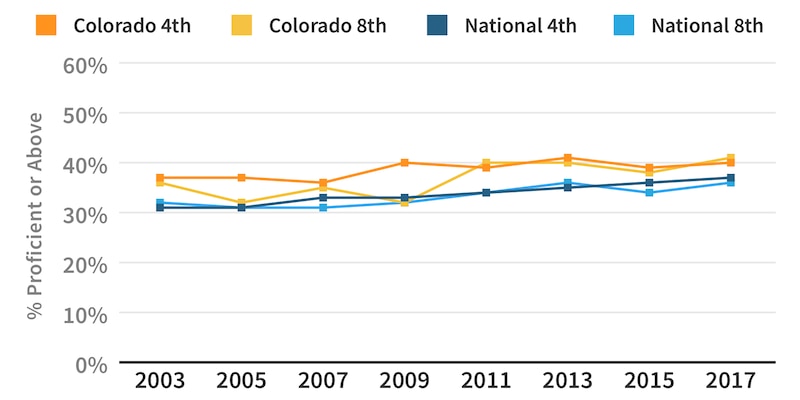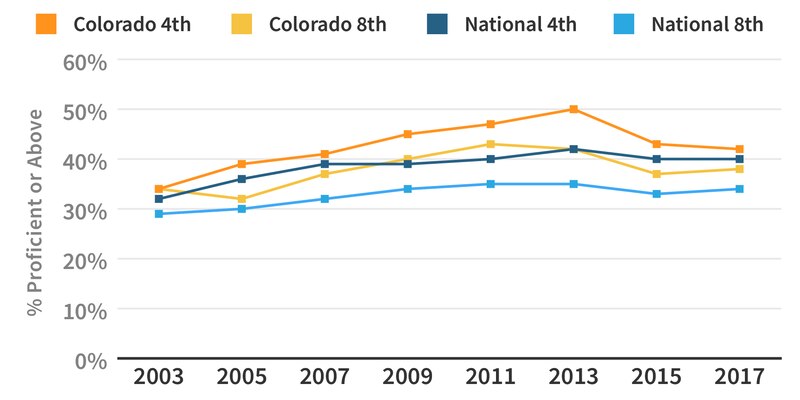Colorado students improved slightly last year on the standardized tests known as “the nation’s report card,” bouncing back after a dip in scores in 2015, according to data released Monday.
Colorado’s scores in reading and math remained above national averages, but not by enough to make them statistically significant. That’s according to the government agency that administers the National Assessment of Educational Progress, or NAEP, tests every two years. The improvements Colorado students made in 2017 also were not statistically significant.
So, essentially, Colorado’s scores were flat and average.
However, most of the state’s achievement gaps between more privileged and less privileged students were slightly bigger than national averages, with some considered significantly larger. They included gaps in math scores between white and Hispanic students, and between students who are English language learners and students who are not.
Will Morton, the director of assessment administration for the Colorado Department of Education, said the state has been working to shrink the gaps – and yet, they remain.
“What it means is as a state, we’re not doing a better job at serving the underserved,” he said.
Colorado reading scores

The National Assessment of Educational Progress is a set of reading and math tests given every two years to a sample of fourth and eighth graders in each state. Scores from 27 large, urban school districts, including Denver Public Schools, are reported separately this year.
Colorado education officials said this year’s scores were in line with previous scores.
In math, 42 percent of Colorado fourth-graders and 38 percent of Colorado eighth-graders scored proficient or better in 2017. In reading, 40 percent of Colorado fourth-graders and 41 percent of Colorado eighth-graders scored proficient or better.
Scoring proficient or better does not necessarily mean a student is on grade level, according to the National Center for Education Statistics, the government agency that administers the tests.
Colorado math scores

Nationwide, scores were mostly stagnant. The 2017 results showed only tiny differences from 2015: a loss of 1 point in both subjects in fourth grade, and a gain of 1 point in both subjects in eighth grade, on a 500-point scale.
The country’s achievement gaps, including those between black and white students, and between students from low-income families and students from more affluent families, have also largely held steady over the last two years (and the last decade).
In Colorado, most achievement gaps stayed the same or shrunk slightly from when the tests were last administered in 2015. But a few grew, including the gap in math scores between eighth-graders who are English language learners and eighth-graders who are not.
That gap was among those testing officials considered “significantly different from the nation.” Nationwide, the gap in math scores between eighth-graders who are English language learners and eighth-graders who are not was 39 points. Colorado’s gap was 50 points. Utah had the highest gap in the country for eighth-grade English language learners, at 56 points.
Colorado also had significant gaps between fourth-grade students with and without disabilities in both reading and math. The gap in reading scores was the largest of Colorado’s gaps at 53 points, which was significantly bigger than the national gap of 40 points. Vermont and Idaho tied for having the biggest gap in the country for those students, at 56 points.
“Colorado, like much of the rest of the country, still has work to do to close our achievement gaps, but I know that our teachers are already working long, hard hours to meet the needs of students,” Katy Anthes, Colorado’s education commissioner, said in a statement.
“I believe that teachers can’t do it alone,” she said. “We need to rally entire communities around our students to meet their needs before, during, and after they enter and leave the school building each morning, so they all have equal access to the educational opportunities at school.”

